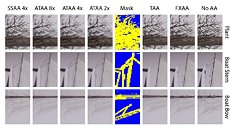Wednesday, August 1st 2018

NVIDIA Unveils Adaptive Temporal Anti-Aliasing with Ray-Tracing
NVIDIA published the first documentation of Adaptive Temporal Anti-Aliasing (ATAA), an evolution of TAA that incorporates real-time ray-tracing, or at least the low light-count method NVIDIA implemented with RTX. Its "adaptive" nature also lets it overcome many of the performance challenges users encounter with TAA in high framerate and rapidly changing 3D scenes, such as in games. Non-gaming scenes, such as those used by real-estate developers, don't face these challenges.
To developers, ATAA promises image quality comparable to 8x supersampling at a cost of under 33 ms frame delay. These numbers were derived on a TITAN V ("Volta"), using Unreal Engine 4. It could take a while for ATAA to make it to games, as developers will need a few months to learn the technique before implementing them in their ongoing or future projects. NVIDIA will introduce ATAA support through driver updates.
Sources:
NVIDIA (PDF), Videocardz
To developers, ATAA promises image quality comparable to 8x supersampling at a cost of under 33 ms frame delay. These numbers were derived on a TITAN V ("Volta"), using Unreal Engine 4. It could take a while for ATAA to make it to games, as developers will need a few months to learn the technique before implementing them in their ongoing or future projects. NVIDIA will introduce ATAA support through driver updates.

71 Comments on NVIDIA Unveils Adaptive Temporal Anti-Aliasing with Ray-Tracing
Want some old info? Here's some:
www.extremetech.com/extreme/206517-revisiting-gameworks-amd-nvidia-tangle-over-optimizations-to-the-witcher-3-wild-hunt
How about some more recent:
www.tomshardware.com/reviews/final-fantasy-xv-performance-analysis,5513-7.html
nVidia WILL hurt their OWN users if, doing so, hurts competition users more.
Just because a setting's there doesn't mean it needs to be used. This type of AA falls right into that category.
At the same time Gameworks and the funding poured into it has also brought good stuff to games. As long as its optional I really don't see the issue.
However, if nvidia inflates the prices of new gpus to push tensor cores to help with with new, rtx based gameworks then I guess they're not getting my money this time. Used 1080Ti it is. or this friggin rad Titan jedi I've been eyeballing
allegro.pl/nvidia-titan-xp-star-wars-collectors-edition-jedi-i7473397682.html
We can assume anything, without numbers we're either venting or just keeping ourselves busy.The practice of what? Of features not being perfectly equally taxing on all hardware?
Boy,you have major anger issues.
If you're just doing real estate virtual tours, that one second delay is fine (probably why they felt like announcing that detail). Not for gaming.
See, this whole chain of postprocessing filters are revolutionary because they contrive a better compromise than +2xMSAA. MSAA is still needed for Z testing, as postprocess filters just skip this part, however once a 'boundary' is 'marked' it is useless to test further the ratio of the approximate geometry - postprocessing can do that better by looking at the morphology of where the boundary edges extend to: a.k.a MLAA/SMAA.
Beyond that which postprocessing filters do for the geometry, there is 'literally' zero benefit to them because you are just writing over very expensive anisotropically filtered texture data. It is plain nonsense to think SSAA - which has an equal part of anisotropical filtering as well as antialiasing - can be superseded by a cheap shot approximate.
Just because this article was released from a "click bait friendly" site doesn't make it bad.
What else, the algorithm is plain wrong. When comparing 4 subpixels, you 'can' use the normal template of box-quad arrangement. When doing 8 subpixels, you are literally comparing against the neighbouring pixels, a.k.a bilateral filtering(weighted sample). I couldn't imagine why it will turn out blurry.
This looks promising. The example shows that it seems to do better than standard AA techniques. And for those who didn't read the entire article, NVidia will be including this in future drive updates, which implies that it will likely be supported in hardware through adjustments to the coding.
So just keep releasing faster GPUs.
Done.
Go home Nvidia your drunk, stop investing and start counting all that cash.